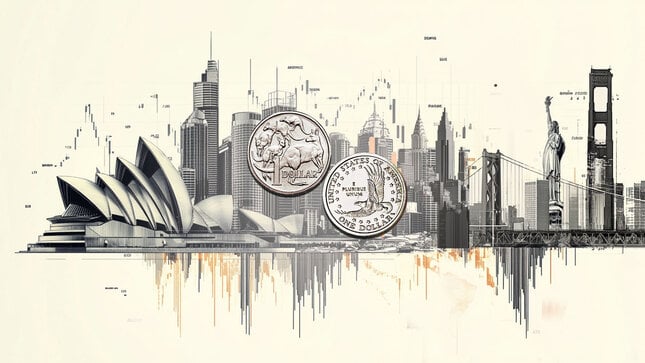One of the basic problems humans have encountered since the dawn of time is how to exchange goods and services for a known value.
If I owned a goat, but I needed a knife, would I exchange the whole goat or just half of it for the knife? How can I do this without a comparison or a way of knowing what the knife is worth? What happens to the other half of the goat – and what if I learn the knife was only worth a quarter of the goat - how do I get a refund?
Over millennia, the solution we came up with was to use precious metals – gold and silver – as a benchmark of value.
An exact weight, or piece of gold or silver in a known format – like a coin – became the standard way of comparing prices. A coin had a specific value and acted as a means of exchange.
This was much tidier to deal with than lots of disparate, subjective, constantly changing things like "a bushel of wheat" or "a ton of oak."
It was only logical that when paper money was created, to overcome the necessity of carrying heavy coinage and bullion and transporting it, the notes were "pegged" to the value of gold or silver. This meant that we could exchange the paper money for a known quantity of precious metal and give it solidity, tangibility, and fungibility.
The concept of “paper” backed by precious metal became known as a "standard."
Historically, silver has been used as the primary currency and unit of account for domestic economies. Silver coins were widely accepted and used in the payment of wages and salaries, as well as most local retail trade for centuries across the world.
Gold was also used as money, but it was not until the 18th century that economic systems using gold as the sole currency and unit of account emerged.
This was because of problems such as divisibility.
Gold coins were too small and rare to be practical for daily transactions. Silver coins could easily be used for daily labor costs and food purchases. Because of their lower value, there were more silver coins in circulation.
As a result, a bimetallic standard, which combined gold and silver currencies, was widely adopted until the 19th century.
This system allowed people to use either gold or silver depending on their preference or needs at any given time.
Using gold as money began as early as 600 BCE in Asia Minor and the metal has since become a widely accepted form of currency.
However, it wasn’t until the 19th century that tools such as divisibility became practical. This made it possible for gold to function effectively as a currency and unit of account for daily transactions and displace silver.
In 1873, the German Empire switched from the South German gulden and the silver North German thaler to the gold German mark. This was the beginning of the worldwide classical gold standard.
In light of the consensus reached at the monetary conferences of the 1860s, Germany made this choice. At the conclusion of the Franco-Prussian War, Germany spent the 5 billion gold francs (equivalent to 4.05 billion marks or 1,451 metric tons) in reparations sought from France.
As a result of this change by a major, centralized European economy, other European nations also made the changeover to gold in the 1870s, and the Latin Monetary Union stopped minting limitless quantities of silver 5-franc coins.
During this time, several monetary systems made the transition from silver or bimetallic currencies to gold, including the British Empire.
Following Austria’s lead, several other nations made the change, including Belgium, Denmark, France, Italy, the Netherlands, and Sweden.
Stability in international trade and commerce, as well as increased economic activity in Europe and the United States, were made possible by the international adoption of a classical gold standard.
As a result of this gold standard's fixed exchange rates, the world's price levels began to rise and fall in sync with each other because of the new “automated” balance of payments.
The United States dollar had also been a major currency in the world for decades. It was the first currency to be used across all the newly formed United States of America, and gold backed it until 1933.
After a joint resolution was enacted by Congress on June 5, 1933, creditors could no longer demand gold as payment.
Since 1879, with the exception of a gold export embargo during World War I, the United States has been on a gold standard; however, widespread bank failures in the 1930s caused the public to panic and hoard gold, making the policy unsustainable.
President Roosevelt ordered a countrywide bank moratorium shortly after taking office in March 1933 in order to avoid a run on the banks by customers who lacked faith in the economy. He also prohibited banks from paying out or exporting gold.
This settled the markets - until the Second World War.
War doesn't come cheap, and all major economies found themselves faced with unsustainable debt.
At the end of the war, the gold standard was revived, and the Bretton Woods agreement was set up.
These two measures became an international monetary system based on fixed exchange rates backed by central banks and set against principal currencies like the U.S Dollar and British Pound Sterling.
It allowed nations taking part to maintain convertibility between different currencies without using surplus foreign exchange reserves or speculative capital flows. Both governments and businesses used this new global system for foreign exchange transactions over decades.
But, in 1971, President Nixon suspended all dollar-related transactions backed by gold in response to increasing price instability. This was due to inflationary pressures domestically and abroad, the Vietnam War, and increased government spending.
Aggressive social welfare programs and high defense costs fueled this spending on projects such as missile defense throughout Europe during the final years of the "Cold War."
The Fed then hit on inflation and juggling with interest rates as a financial weapon, and a "fiat" currency - backed by only a government promise to pay - was the perfect solution to the debt spiral the U.S. found itself in.
If it needed money - it simply printed it.
And the rest, as they say, is history …
We'll leave you with just two numbers:
Recently, U.S. debt topped $32,500,000,000,000 - that's around $95,000 for each citizen.
Since 1960, Congress has allowed the raising of the debt limit 78 times - and there seems no sign of this stopping anytime soon.
All statements presented in this website are the exclusive opinions of NOBLE GOLD, INC. and no other party. It must be emphasized that the performance of investments or purchases that have occurred previously may not be taken as predicting future performance or results. Investing in precious metals, including gold coins, gold or silver bars, involve risks, and may not be appropriate for all investors. The value of these items may change depending on various conditions, and may fluctuate, accordingly. NOBLE GOLD, INC. makes no representations or guarantees that metals purchased will appreciate in value. Any decision to buy or sell precious metals must be that of the customer, acting alone, and should be made with caution, on the basis of the customer’s own personal investigation and research, and exclusive judgment. By accessing the information presented on this website and utilizing the services of NOBLE GOLD, INC. you hereby agree to be bound by the terms of service and privacy policy of the Company.
Editors’ Picks

AUD/USD hangs near one-week low; downside seems limited
AUD/USD trades with a negative bias for the fifth straight day on Wednesday, just above a one-week low touched the previous day, as a weaker risk tone and China's economic woes undermine the Aussie. However, the RBA's hawkish stance could limit deeper losses. Moreover, bets for more rate cuts by the Fed in 2026 keep a lid on the attempted US Dollar recovery, warranting some caution for bearish traders ahead of US CPI on Thursday.

USD/JPY weakens below 155.00 as BoJ rate hike speculation grows
The USD/JPY pair attracts some sellers near 154.80 during the early Asian session on Wednesday. The Japanese Yen strengthens against the US Dollar amid growing speculation that the Bank of Japan will hike rates to 0.75% on Friday.

Gold extends the range play around $4,300
Gold edges higher during the Asian session on Wednesday, though it remains confined in a multi-day-old trading range. Dovish Fed-inspired bearish sentiment surrounding the US Dollar, along with the risk-off mood, acts as a tailwind for the safe-haven bullion. However, hopes for a Russia-Ukraine peace deal hold back the XAU/USD bulls from placing aggressive bets. Traders also seem reluctant ahead of the crucial US consumer inflation figures on Thursday.

XRP dips as bearish pressure persists despite ETF growth
Ripple is finding footing above $1.90 at the time of writing on Tuesday after a bearish wave swept across the broader cryptocurrency market, building on persistent negative sentiment.

Ukraine-Russia in the spotlight once again
Since the start of the week, gold’s price has moved lower, but has yet to erase the gains made last week. In today’s report we intend to focus on the newest round of peace talks between Russia and Ukraine, whilst noting the release of the US Employment data later on day and end our report with an update in regards to the tensions brewing in Venezuela.
RECOMMENDED LESSONS
Making money in forex is easy if you know how the bankers trade!
I’m often mystified in my educational forex articles why so many traders struggle to make consistent money out of forex trading. The answer has more to do with what they don’t know than what they do know. After working in investment banks for 20 years many of which were as a Chief trader its second knowledge how to extract cash out of the market.
5 Forex News Events You Need To Know
In the fast moving world of currency markets where huge moves can seemingly come from nowhere, it is extremely important for new traders to learn about the various economic indicators and forex news events and releases that shape the markets. Indeed, quickly getting a handle on which data to look out for, what it means, and how to trade it can see new traders quickly become far more profitable and sets up the road to long term success.
Top 10 Chart Patterns Every Trader Should Know
Chart patterns are one of the most effective trading tools for a trader. They are pure price-action, and form on the basis of underlying buying and selling pressure. Chart patterns have a proven track-record, and traders use them to identify continuation or reversal signals, to open positions and identify price targets.
7 Ways to Avoid Forex Scams
The forex industry is recently seeing more and more scams. Here are 7 ways to avoid losing your money in such scams: Forex scams are becoming frequent. Michael Greenberg reports on luxurious expenses, including a submarine bought from the money taken from forex traders. Here’s another report of a forex fraud. So, how can we avoid falling in such forex scams?
What Are the 10 Fatal Mistakes Traders Make
Trading is exciting. Trading is hard. Trading is extremely hard. Some say that it takes more than 10,000 hours to master. Others believe that trading is the way to quick riches. They might be both wrong. What is important to know that no matter how experienced you are, mistakes will be part of the trading process.
The challenge: Timing the market and trader psychology
Successful trading often comes down to timing – entering and exiting trades at the right moments. Yet timing the market is notoriously difficult, largely because human psychology can derail even the best plans. Two powerful emotions in particular – fear and greed – tend to drive trading decisions off course.

